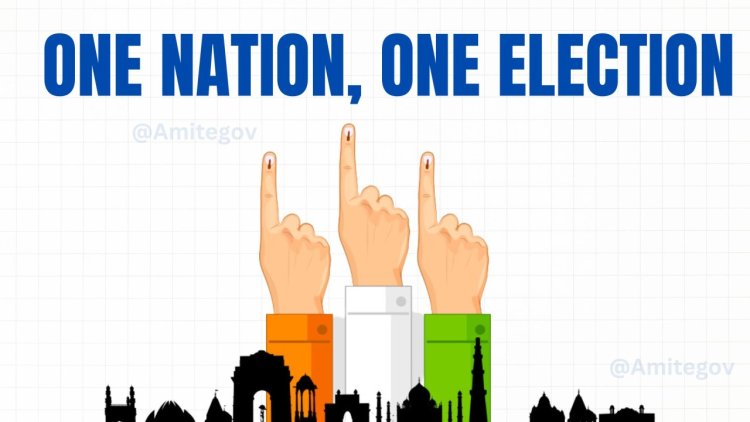Understanding One Nation, One Election: The pros and cons and its complexities
A deep dive into the concept of One Nation, One Election in India, studying the advantages, disadvantages, and complexity involved in its implementation.

The concept of "One nation, One election" has been discussed and debated in India in recent years. It envisions elections to the Lok Sabha (the national parliament) and state legislative assemblies being held simultaneously to simplify the electoral process and improve governance. The idea is not entirely new, having been implemented in India from 1951 to 1967. However, political instability disrupted this system, and the tradition of staggered elections at different levels of government became the norm.
In this article, we will examine the historical context and current motivations for the concept of "one nation, one election." We will look at the economic and governance benefits it promises, as well as the political concerns and accountability involved. We will also examine the obstacles and possible solutions to implementing this system and weigh the pros and cons of One Nation, One Election to gain a comprehensive understanding of the complexity of the concept.
Explore the historical context and current motivation behind One Nation, One Election.
To understand the concept of "One Nation, One Election," we need to look at the historical context. From 1951 to 1967, India held simultaneous elections for the Lok Sabha and state legislative assemblies. However, this system was interrupted due to political instability, and subsequent elections were held on a delayed basis.
In recent years, the government has cited the inefficiency of the Model Code of Conduct in elections as the driving force behind the idea of reintroducing simultaneous elections. The Model Code of Conduct restricts the initiation of new projects and policy decisions during the election period, leading to delays in governance. By combining all elections, the government aims to overcome this inefficiency and create a continuous governance framework.
Economic and regulatory advantages of "One Nation, One Election
One of the main benefits of One Nation, One Election is the potential cost savings that will result. Holding elections separately results in a significant increase in campaign costs. In recent elections in India, the cost of holding separate elections to the Lok Sabha and state legislative assemblies has increased significantly. Costs include campaign costs, security arrangements, logistical expenses, and the deployment of officials for election duties.
Consolidating all elections can save a significant amount of money, estimated at about 2,000 million euros. These savings can be used for other development initiatives and welfare programmes. In addition, the indirect costs associated with elections, such as security arrangements and logistical expenses, can be minimised.
In addition, a One Nation, One Election would optimise the use of resources. Currently, politicians and officials are heavily involved in election-related activities throughout the year, which affects their ability to focus on government work. By synchronising elections, politicians and civil servants would have more time for governance and policy-making, leading to improved efficiency in decision-making processes and project implementation.
Political and Accountability Aspects Related to One Nation, One Election
While the "One Nation, One Election" concept offers economic and regulatory benefits, it also raises concerns about political dynamics and accountability. Critics argue that simultaneous elections could overshadow local issues and favour national parties over regional parties. Local issues that are critical to voters' daily lives could be eclipsed by the dominance of national issues in the "One Nation, One Choice" campaign.
Moreover, staggered elections play an important role in holding politicians accountable. In India's federal system, state elections often serve to evaluate the performance of political parties and their leaders. Politicians know that their performance in state elections can affect their chances in subsequent national elections. Staggered elections ensure that politicians are constantly under scrutiny and accountable to voters.
Obstacles and possible solutions to implementing One Nation, One Election
Implementing the concept of "One Nation, One Election" in India presents a number of obstacles. One of the biggest challenges is regulating the terms of office of governments at the national and state levels. Currently, elections are held according to constitutional provisions, and state governments can fall or dissolve before their terms expire. Regulating the terms of all governments uniformly could be a complex task and require a constitutional amendment.
Another obstacle is the synchronisation of voter rolls. Each state has its own voter rolls, and ensuring accuracy and synchronisation at the national level would require significant effort and resources.
Possible solutions to these obstacles include exploring the possibility of holding midterm elections for synchronised terms and creating a centralised voter registration system. These approaches would require careful consideration and consensus among all stakeholders.
The Debate: Weighing the Pros and Cons of One Nation, One Election
The concept of "One Nation, One Election" has sparked a lively debate among politicians, pundits, and citizens in India. Proponents believe it will streamline the electoral process, cut costs, and increase government efficiency. They argue that elected representatives will then be able to concentrate on their real task, governing, and not be trapped in constant election cycles.
On the other hand, opponents argue that staggered elections provide better checks and balances and promote political accountability. According to statistical studies, they believe that simultaneous elections could give the ruling party an advantage in both national and state elections.
Ultimately, the decision about whether or not "One Nation, One Election" is beneficial rests with the observer. It requires a nuanced understanding of both the benefits and concerns associated with this concept. A thorough analysis of the historical context, economic impact, governance benefits, political dynamics, and potential obstacles will help in this decision.
As India continues to explore the feasibility of One Nation, One Election, it is important to have meaningful and well-informed discussions to ensure that any potential changes to the electoral system serve the best interests of the country and its democracy.
Disclaimer: The views expressed in this article are for informational purposes only and do not reflect any political bias or advocacy.
Having said that….
You can join our Forex Managed account program and earn 1-2% profits daily. See for yourself by clicking the below link.
Have a great journey, and may you catch some big waves on your way to prosperity!
To see Ai Forex Trading for real, click here.
https://www.myfxbook.com/members/SankarGanesan/TradeFxP-trend-antitrend-day-trading/10404725
To read why you should be with us, click here
To open an account, click here.
To see our regulation certificate: click here.
To see our news with the IFMRRC: click here.
For claims, click here.
For the main site: click here.
For blogs and articles: click here.
Main Website: www.TradeFxP.com



 admin
admin 










